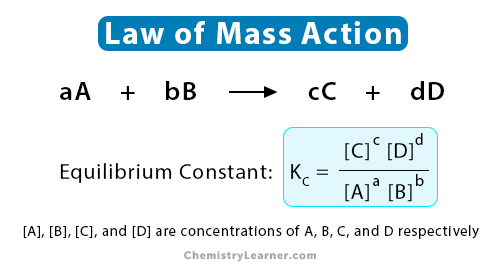Law of Mass Action
The law of mass action states that the reaction rate is proportional to the product of the reactants’ concentration raised to the power of their stoichiometric coefficients in the balanced chemical equation. Specifically, this law explains that in a chemical equilibrium between the reactants and products, the ratio between the concentrations of the reactants and products remains constant [1-4].
The law explains the behavior of solutions in closed systems at dynamic equilibrium, leading to a reaction constant known as the equilibrium constant. An application of this law is in electronics. It establishes a relationship between the concentration of holes and free electrons in a semiconductor system at thermal equilibrium.
Equilibrium Constant [1-4]
Consider a chemical reaction between the reactants A and B to give the products C and D.
aA + bB ⇄ cC + dD
where a, b, c, and d are the stoichiometric coefficients of A, B, C, and D, respectively.
According to the law of mass action, the rate of the forward reaction is given by
rf ∝ [A]a[B]b
=> rf = kf [A]a[B]b
where [A], [B], [C], and [D] are the molar concentrations of A, B, C, and D, respectively. kf is a proportionality constant.
Similarly, the reverse reaction rate is given by
rr = kr [C]c[D]d
At chemical equilibrium, the forward and the reverse reaction rates are equal.
rf = rr
=> kf [A]a[B]b = kr [C]c[D]d
=> kf/kr = [A]a[B]b / [C]c[D]d = KC
Here, KC is known as the equilibrium constant.
If the reaction is not in equilibrium, then the ratio is called the reaction quotient (KQ) and differs from the equilibrium constant. As the reaction proceeds toward equilibrium, KQ → KC
Other Representations of the Equilibrium Constant
Partial Pressure
If the reactants and the products are in a gaseous state, their partial pressures (p) are used instead of molar concentrations.
KP = pCc · pDd/ pAa · pBb
Molar Fraction
If the concentrations are expressed in molar fractions (X), the equilibrium constant is represented as follows:
KC = [XC]c[XD]d/[XA]a[XB]b





